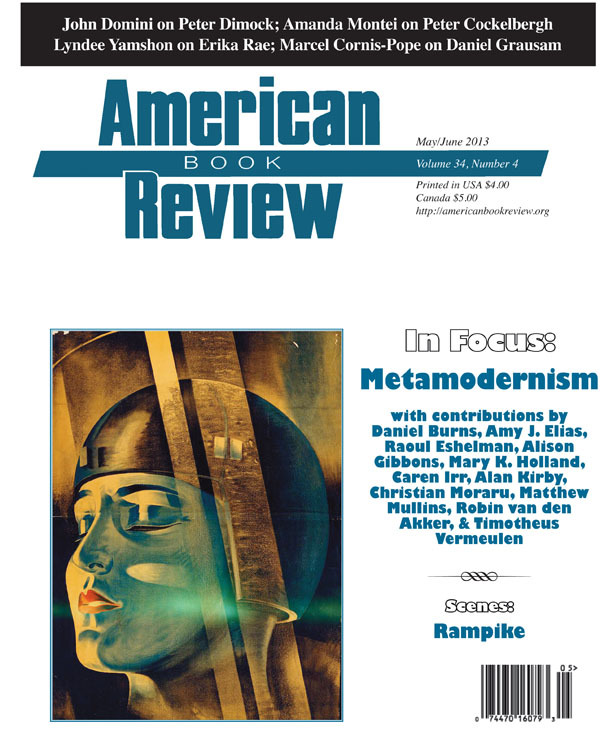
The American Book Review (34: 4) dedicated a special issue to metamodernism. It includes review essays by, among others, NoM editors Timotheus Vermeulen, Robin van den Akker and Alison Gibbons and fellow travellers Alan Kirby and Raoul Eshelman, alongside a very interesting introduction by our colleague and friend Christian Moraru, the issue’s editor. In “Thirteen ways of passing postmodernism”, Moraru argues that the contemporary metamodern moment should be situated between the bygone postmodern years and ‘the next big thing’ of the (un)foreseeable future.[i] Meanwhile, he writes, we have our “work cut out” for us, ”because lots of unanswered questions still swirl around metamodernism.” The eleven review essays included in the special issue form, then, a welcome contribution to the running debate on the contemporary hosted on this site. Here are some excerpts from his introduction:
[. . . ] Many would suggest that, for some time now, we have been witnessing the weakening if not the “passing” of postmodernism [. . .] The question or questions remain, however, if this passing equals a neatly demarcated exit and thus the end of an era; if the cohort of hot rods and fancy imports so eager to leave the postmodern behind—digimodernism, performatism, globalism, cosmodernism, planetarism, hypermodernism, altermodernism, etc.—are sufficiently marked stylistically, thematically, and otherwise; if the ironic, parodic, manifestly intertextual, and cross-generic discursive signals they send as they pick up speed on the highway of aesthetic and cultural history allow for an effectively individualizing profile; if authors who have driven previous shifts in taste and form and still are central to the postmodern, postcolonial, and multiethnic canons in the U. S. and abroad—from Don DeLillo, David Foster Wallace, Chang-rae Lee, Junot Díaz, and Mark Z. Danielewski to Zadie Smith, Michel Houellebecq, Haruki Murakami, Orhan Pamuk, and Roberto Bolaño—can be cavalierly enlisted in a Paradigmenwechsel argument plausibly geared toward the supplanting of postmodernism; if, more specifically, a writer like DeLillo can be postmodern in White Noise and post-postmodern in Point Omega (whose whole point—no pun intended—is an echo to Teilhard de Chardin’s “point Omega” from Le Phénomène humain); if the decoupling of the postmodern and the poststructural has really occurred; if the digital, Internet-based experiments of style, format, and venue à la Jennifer Egan will ever reach critical mass or will ever amount to more than a digitalization of the postmodern; and if the much-advertised return to realism, new eclecticism, new “earnestness” or “sincerity” (and to “new weirdness” too), along with the comeback of the empathic, the ethical, and the metaphysical, and the temptation of the “post-identitarian” and of the “grand narratives” will prove enough to set off a well-configured, epoch-making paradigm shift away from postmodernism and to something else, truly, if awkwardly labeled, post-postmodern. [. . .]
As far as I am concerned, the metamodern is not so much a name for [a] novel cultural movement or trend, a contender in a pool in which others seem geoculturally and historically more capacious, more inclusive, and generally better positioned to supply the new critical-theoretical frameworks and vocabularies. Still stemming mostly from the Western tradition in the arts and philosophy, metamodernism is, to my mind, best understood as a primarily formal (stylistic-generic) and secondarily thematic-philosophical model best describing, at the textual-discursive level and especially in the West, postmodernism’s passing by and into the “next big thing.” Think of it, if you will, as a defining set of features [. . .] or aesthetic markers more and more favored by a growing spate of works after the Cold War, in direct and indirect reaction to the postmodern—as a formal protocol for taking us beyond postmodernism. Yet again, the Ancient Greek metá in “metamodernism” means a host of conflicting things, from the co-temporal/co-spatial “among” and “besides” to “afterwards.” As such, it engages the postmodern in several scenarios at once: co-presence, parallelism, coexistence, as well as competition, antagonism, succession, and so forth. It does the same, I might add, with the modern. In response to pressures exerted by metamodernism as well as by postcolonialism, globalism, and planetarism, modernism itself diversifies, multiplies, goes local, and is even getting new leases on life—we are talking about “modernisms” these days, “global,” “post-national,” “cosmopolitan,” non-Western, and the like.
You can find ABR’s special issue on metamodernism here.
[i] For him, as he argues here and elsewhere, the ‘next big thing’ may very well be structured around a future condition that is planetary and a future culture that is dominated by cosmodernism. We have to leave our own take on all of this for another post and another time. It suffices, here, to state that we do not necessarily disagree. For us, the postmodern and the metamodern are historically original cultural moments bound to the urban condition (just as realism and modernism must be situated in the context of the industrial condition).

Just thought I would pop in and write that the reviews I have read so far, by Vermeulen, van den Akker, and Holland, are incredibly insightful. Though I still am not completely convinced of the reimagining of DeLillo’s text.